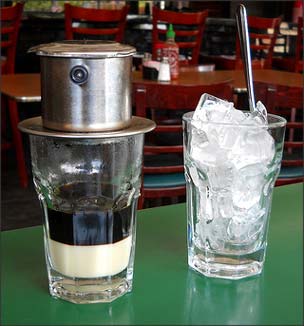See the scan copy. Let’s try Gf$% Don't Miss!Seven Yummy Coffee Desse...
Vietnamese coffee is like nothing else. I developed a taste for it when I was living close to a small Vietnamese lunch counter. Normally, I ordered a cup of American coffee with my meal. One rainy evening when I was the only customer in the place, the owner stood by my table while I ate, talking about this and that and the other. When it came time for my coffee, he smiled and said, “You try my coffee tonight.” In an agreeable sort of mood, I – well – agreed. Sublime does not do the flavor justice. Nor does mere description. If someone had told me that Vietnamese coffee is very strong coffee mixed with sweetened, condensed milk, I could no more have imagined the flavor of Vietnamese coffee than if someone had told me that ice cream is frozen milk with sugar and flavoring added.

In the early part of the 20th century, Vietnam was a major exporter of coffee. Originally brought to the hilly interior of the country by the French, it rapidly became a major cash crop. Those wet, mountainous inner regions are ideal for growing robusta coffee, which is often regarded as being less flavorful and more bitter than arabica coffee. Coffee production and export slowed to a mere trickle during and after the Vietnam war, but in the early 1980s, Vietnamese coffee once again began to creep into the marketplace. Without much fanfare, Vietnam gradually increased the size of its export coffee market. As of 2004, Vietnamese coffee exports were second only to Brazil. While robusta coffee is seen as making inferior coffee to arabica beans, it is often blended with arabica beans in supermarket blends for sale to the general public. The robusta beans grown in central Vietnam are ideal for making Vietnamese coffee, and many espresso afficionadoes favor robusta beans for espresso as well.
Like Turkish coffee and espresso, making Vietnamese coffee involves its own little secrets and rituals. The coffee, called ca phe, is actually brewed in a miniature drip pot that sits on top of your coffee cup. The “cup” is more usually a glass, because Vietnamese coffee is as much a treat for the eyes as it is for the tongue. The Vietnamese coffee pot looks a bit like a top hat. The rim is designed to sit on the rim of the glass. Inside, the coffee pot consists of the chamber and a filter. The filter lid unscrews from the body of the coffee pot so that you can add the coffee and then cover it.
Unscrew the filter insert and remove it from the pot.
Spoon about two tablespoons of very finely ground Vietnamese coffee into the pot. If you can’t find Vietnamese coffee, try Luzianne coffee with chicory. In fact, many experts claim that it isn’t Vietnamese coffee without the chicory.
Replace the filter insert and screw it down tightly over the coffee grounds. This serves the same purpose as tamping the filter basket when making espresso. It compresses the coffee into a hard puck and slows the process of the water through the ground coffee, giving it time to extract all the flavor.
Pour about 1/3 of an inch of sweetened condensed milk into the bottom of your coffee glass or cup. Place the Vietnamese coffee pot over the rim of your cup or glass.
Pour one cup of water just off the boil into the pot over the filter top. Cover the pot and wait.
The coffee will take its time. More than almost any other method of making coffee save perhaps Turkish coffee, drinking Vietnamese coffee encourages a leisurely attitude. It is not coffee for the rushed and impatient. It can take ten minutes or more for the water to finish dripping through the coffee grounds into the glass, transformed into thick, rich, velvety coffee. The coffee, being of different density, simply sits on top of the milk, forming three distinct layers – the creamy milk at the bottom, a very thin layer of caramel colored coffee that has dissolved some of the milk, and the thick coffee on the top.
Remove the coffee top hat from the glass and set it on a saucer or plate beside you. Stir up the coffee and milk with a spoon and enjoy.
Some posts on our site may contain amazon affiliate links. We may earn affiliate commission from amazon when you purchase through those links.
Dom Esi says
Hello,
WE like your website- just found it and will be back. However, in your article “How to make Vietnamese Ca Phe”, you omitted one important step: once the “off-boiled” water is poured on the filter and begins to drip, about 10 seconds, you must lift the filter away from the grounds (about 1/2 inch) for a few seconds and allow the grounds to expand a little. Then drop it back down on the coffee. This step is important to avoid the “hard puck” from restricting the slow drip. I have broken off the center screw on all my drips and it works great. I’ve been making my coffee like this for 27 years.
Best Regards,
Dom Esi